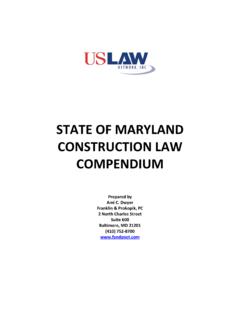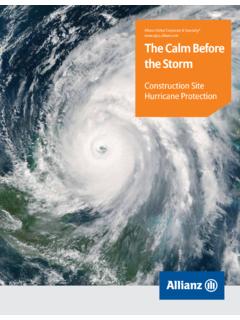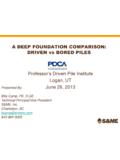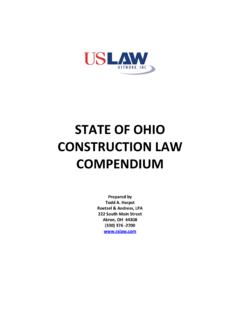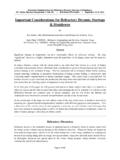Transcription of Relevant Court Cases CONSTRUCTIVE VIEW - jlta.com.au
1 Defects ExclusionsJardine Lloyd Thompson Pty Ltd ABN 69 009 098 864 AFS Licence Level 11, 66 Clarence Street, Sydney NSW 2000. T: +61 2 9290 8000 F: +61 2 9299 7280 CONSTRUCTIVE VIEW | ISSUE 1 Construction projects like any other risk requires a balance of risk control and risk transfer as part of ongoing risk management exercises and it is how contractors, developers and owners decide to balance these two elements that often determines how successful a project will be. Risk control methods such as quality control, subcontractor management, site security and safety are heavily utilised by the industry but such measures cannot completely remove risk from a project.
2 Risk managers therefore generally elect to transfer the remaining risks with the insurance market being the principal method utilised for risk insurance industry has developed specialist insurance products that offer contractors, developers and owners comprehensive risk transfer solutions for the unique risks that construction projects pose. Although these insurance products are now quite familiar to the construction industry there are certain aspects of coverage that are often overlooked and/or underappreciated by insureds that can make a significant difference in a claims situation. JLT has therefore decided to produce a series of White Papers that explore some of these aspects of cover in more detail.
3 In this first White Paper we explain the different levels of coverage available under Contract Works policies in respect of defects and how the differing levels of coverage would respond in a claim VIEWJLT S CONSTRUCTION INSURANCE WHITE PAPER ISSUE 1 INTRODUCTIONC ontract Works insurance policies in Australia (and other parts of the world) provide varying coverage responses for defects and whilst the drafting of these clauses may be subtle, they can have a dramatic impact on the policy response to a as a result of defects during the construction of a project can often be significant (potentially running into the millions of dollars).
4 Accordingly, a number of claims made under Contract Works policies (subject to these various defects exclusions) have generated some interesting Court decisions over the years, particularly in courts approach in Australia is generally to rely on the language used in the policy wording,examining the words used in minute detail (rather than necessarily understanding the original intent of coverage). It is for this reason that it is critical for insured parties of a construction project to fully understand and appreciate the subtle (but important) differences in coverage available under Contract Works policies and, with the assistance of your insurance broker, draft a tailored policy that adequately deals with the specific risks of the construction project to be purpose of this paper is to give a brief explanation of the main defects exclusions used in Contract Works policies and the key differences between information contained in this article, which is current as at the date of publication, provides only a general overview of subjects covered.
5 It is not intended to be taken as legal advice or advice regarding any individual situation and should not be relied upon as such. Insureds should consult their insurance and legal advisors regarding specific coverage issues. All insurance coverage is subject to the terms, conditions, and exclusions of the applicable individual OSBORNE Managing Director - Construction/Surety T: +61 2 9290 8063 E: JEEVES General Manager Technical and Marketing T: +61 7 3246 7506 E: arising out of defects during the construction of a project can often be significant. The type of defects exclusion under an insured s Contract Works policy can have a dramatic impact on policy response Relevant Court CasesFor a more in-depth understanding of how defects and defects exclusions may be interpreted by the courts the following UK Cases may be Relevant .
6 Promet Engineering (Singapore) PTE Ltd V Sturge & Others - (cracking nothing more than manifestation of latent defects) Hutchins V Royal Exchange - (Latent damage not defect) Pilkington V CGU - Waterloo station (Glazed units defective but not found to be damaged) Graham Evans & Co (Qld) Pty Ltd V Vanguard - (Layers of paint only the primer found to be defective) Walker Civil Engineering V Sun Alliance - Sewerage tank - (all parts comprised the part immediately affected) Seele Austria Gmbh & KG V Tokio marine - ( Punched Windows - stand alone indemnity and number of events) CA Blackwell V Gerling Allegemeine Versicherungs - (M60 - rainfall damage to earthworks, definition of the part) Cementation Piling v Aegon - (Improvements that are required to achieve the original design requirements are not excluded.)
7 JLT | Construction Insurance White Paper 32 CONSTRUCTIVE VIEW | ISSUE 1 Providing cover by an ExclusionOn the face of it, it seems strange to define a key aspect of cover by stating what is not covered, but the intention is that the defects exclusions are incorporated in a policy wording that has no limitation in the scope of cover granted, in respect of defective design materials and workmanship, following physical damage. The exclusions then precisely restrict cover to the desired level by excluding the aspects that are not to be covered. This is a more precise method and works to the advantage of the insured on the basis that the peril is covered, unless alternative; to start with an outright exclusion and extend cover, would require a much longer wording, with the danger that some events could be considering the defects exclusion, the base policy must have no limitation to the scope of cover provided, for defective design materials and workmanship, prior to the incorporation of the exclusion.
8 The operative clause will typically read The Insurers will indemnify the Insured in respect of physical loss of or damage to any of the Property Insured arising during the Period of Insurance from any cause not excluded. WHAT IS A DEFECT?There are three aspects that are addressed in the Defects Exclusions:Defects of design, plan, specificationThe Design, drawing up of main plans and the like is normally an offsite activity but there can be revisions undertaken on site by the architects, planners, designers and technicians in the site offices. The consequences of an error in the design is that there may be consequential damage if the integrity of the structure has been compromised, or, in the case of machinery, the plant may not operate at all.
9 Or operate outside of specification or suffer who are involved in the design process would normally benefit from cover under their own Professional Indemnity insurance of MaterialsMaterials that are outside of the design criteria and are not fit for the purpose of WorkmanshipThis relates to construction and assembly work that is incorrectly undertaken either on site or off Defects WordingsThere are two key sets of defects wordings used in the Australian market, DE wordings written by the UK CAR Group, designed for Building and Civil Engineering projects and LEG wordings written by the London Engineering Group designed for Electrical and Mechanical ProjectsMARKET STANDARD DE CLAUSE WORDINGSDE1: Outright Defects Exclusion (1995)This Policy excludes loss of or damage to the Property Insured due to defective design plan specification materials or.
10 Extended Defective Condition Exclusion (1995)This Policy excludes loss of or damage to and the cost necessary to replace repair or rectifya) Property Insured which is in a defective condition due to a defect in design plan specification materials or workmanship of such Property Insured or any part thereofb) Property Insured which relies for its support or stability on a) abovec) Property Insured lost or damaged to enable the replacement repair or rectification of Property Insured excluded by a) and b) aboveExclusion a) and b) above shall not apply to other Property Insured which is free of the defective condition but is damaged in consequence the purpose of the Policy and not merely this Exclusion the Property Insured shall not be regarded as lost or damaged solely by virtue of the existence of any defect in design plan specification materials or workmanship in the Property Insured or any part.
